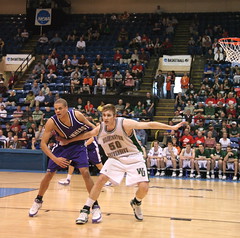Passing into the Post: Spotlight on the Interior Player

Passing into the post is always a challenging exercise and the higher the level of basketball being played the more the defensive players become aware of this area as a scoring threat. So systems and refinement of the defence becomes even more proficient limiting the margin of error for the offensive team.
At the senior and elite levels of the sport the passing phase becomes an area where the errors occur less, so the focus now shifts to the offensive player in the post. Passing into the post should always be discussed as another scenario for a two man game. For the tactic to be executed well, both the perimeter and interior player need to be in sync with one another to create the best possible scoring opportunity.
When breaking down passing into the post, the interior target must take a number of steps to help improve the effectiveness of the tactic. The first is timing. Timing the seal for the interior players is an under emphasised part of playing in the post. If the post player attempts to create a seal and hold too early this increases the chances of not only the defensive player (and team) being able to anticipate what is about to happen but also increases the change of an off the ball offensive foul occurring.
As a general rule the post player should look to create space in the sealing area when the ball is two passes away. With this in mind the post player should look to move their defender away from the area they intend sealing to. For example fake a cut high to then flash low. As the ball then progresses to one pass away the post player should look to seal their defender. This will allow the interior player to be in constant motion which will make defending the player harder.
This will be the hardest point for your players to master. Even players who are undersized can play in the post if they become highly efficient at this technique. The only way players will become proficient in this skills is to practice, practice and practice some more. Feedback is obviously important in this development and video will be invaluable in conveying meaning for your post player in visualising what needs to happen and when.
When passing into the post a common issue is the seal not being strong enough to withstand the physical contact from the defensive player resulting in the offensive player being pushed out of position. To combat this, the offensive player should make their sealing position wide and low. The feet of the offensive player should be at least one and half the width of the player’s shoulders with the player in a squatting position. Arms should be wide of the body creating space and creating a situation where the defensive player has to come over the offensive player to get a deflection.
The position of the arms should be flexed at the elbows (no greater than 90 degrees at the elbow) with the hands finishing no higher than in line with the eyes. Palms should be facing towards the passer.
The post player needs to make physical contact with the defender to initiate and consolidate the seal. The contact while possibly with the upper body initially can be made, the sealing technique of low and wide is commenced contact should move to the lower back, backside and thigh of the offensive player. The area of contact is important because with contact being controlled and maintained with the lower body, the upper body is therefore free to provide as big a target as possible and assist with catching the ball.
As the post player moves into position it is important to make eye contact with the passer. This is a cue for the passer to initiate the pass into the post. This will ultimately help the post player as they will be better prepared to follow the flight of the ball following the pass. As the ability of the perimeter player becomes more advanced at passing into the post the pass will eventually be targeted towards the side away from the defender indicating what way is the open lane to the basket for the post player to attack. Without vision of the passer and the flight of the ball the post player might miss these “reads”.
As a coach be patient with your post players development. Players who play in the post take longer to develop the full suite of skills need to play this position. Be aware that the time post players spend with the ball in their hands is often significantly less than players in other positions. Specific drills which provide high repetitions and breakdown aspects of post play should be part of each training session.




Leave a Reply